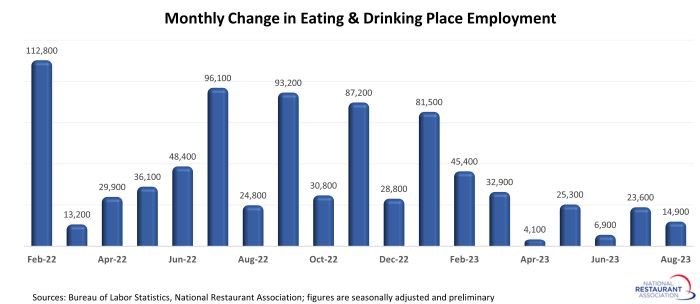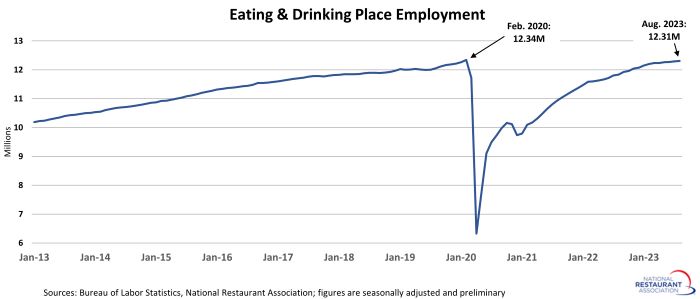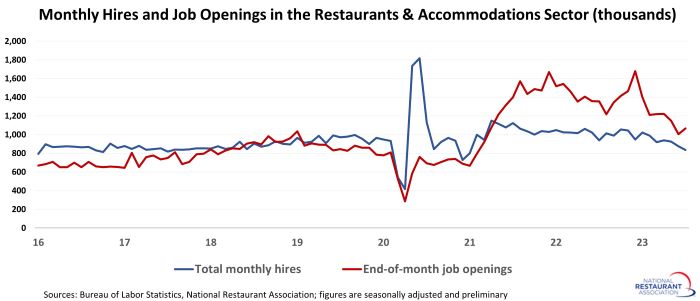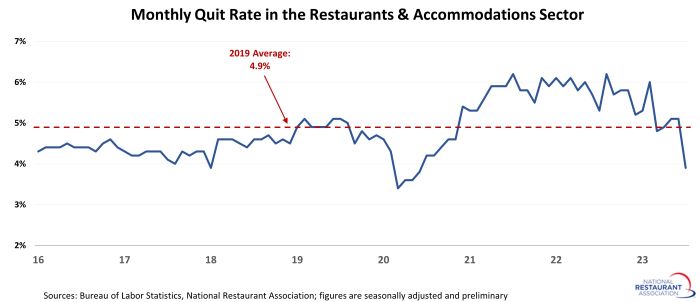Restaurants added nearly 15k jobs in August
The restaurant industry continued to expand payrolls at a modest pace in August. Eating and drinking places* added a net 14,900 jobs in August on a seasonally-adjusted basis, according to preliminary data from the Bureau of Labor Statistics (BLS).
That was essentially on trend with the hiring pace of the April – July period, when payrolls expanded by an average of 15,000 jobs each month.

August marked the 32nd consecutive month of employment gains in the restaurant industry – representing a total increase of nearly 2.6 million jobs.
As a result, the restaurant workforce is inching closer to a full recovery to pre-pandemic levels. As of August 2023, eating and drinking places were 32,400 jobs – or 0.3% – below their February 2020 employment peak.

Labor market dynamics may be shifting
Along with the slower job growth in recent months, new data from the Bureau of Labor Statistics’ Job Openings and Labor Turnover Survey (JOLTS) program suggest that the dynamics of the hospitality sector’s labor market may be shifting.
Although job openings remain elevated in historical terms, the aggregate number of monthly hires and separations – the regular churn in the industry workforce – settled back down to pre-pandemic levels. This potentially signals a return to normalcy, relative to the volatility experienced during the last 3+ years.
[It’s important to note that the figures below are on the national level, and the same trends will not apply evenly by region. All labor markets are local, and significant differences will always exist in communities across the country.]
A downward trend in job openings and hiring
On the last business day of July, there were nearly 1.1 million job openings in the combined restaurants and accommodations sector, according to BLS. Although that represented the 28th consecutive month with at least 1 million openings, it was well below the record-high levels seen in 2021 and 2022 (red line below). This suggests a cooling in the demand for employees, though postings still remained above the 2019 average of 875,000 job openings each month.
Total monthly hiring in the hospitality sector also trended lower in recent months. In July 2023, employers in the restaurants and accommodations sector hired 836,000 people. That was the lowest monthly reading since January 2021 (blue line below). It was also well below the 2019 pre-pandemic levels, when hospitality employers hired an average of 954,000 people each month.
[Note: The ‘hires’ figures represent the total number of additions to the payroll during the month. Net job growth – which for eating and drinking places was 14,900 in August – is the difference between total hires and total separations during the month.]

Employee retention is improving
While the pace of hiring is slowing, restaurant operators are having more success keeping the employees that they have.
Only 3.9% of employees in the combined restaurants and accommodations sector quit their jobs in July, according to BLS. That was nearly two full percentage points below the average monthly quit rate of 5.8% during 2021 and 2022. It was also solidly below 2019’s average monthly quit rate of 4.9%.
One or two months of data does not make a trend, and it’s important to note that the figures presented above are preliminary and will be revised in the coming months. At that point, it will become more clear whether this is a lasting shift in the labor market dynamics or just a temporary blip.

Note: The job openings, hires and quits data presented above are for the broadly-defined Accommodations and Food Services sector (NAICS 72), because the Bureau of Labor Statistics does not report data for restaurants alone. Eating and drinking places account for nearly 90% of jobs in the combined sector.
*Eating and drinking places are the primary component of the total restaurant and foodservice industry, which prior to the COVID-19 pandemic employed more than 12 million out of the total restaurant and foodservice workforce of 15.6 million.
Read more analysis and commentary from the Association's chief economist Bruce Grindy.